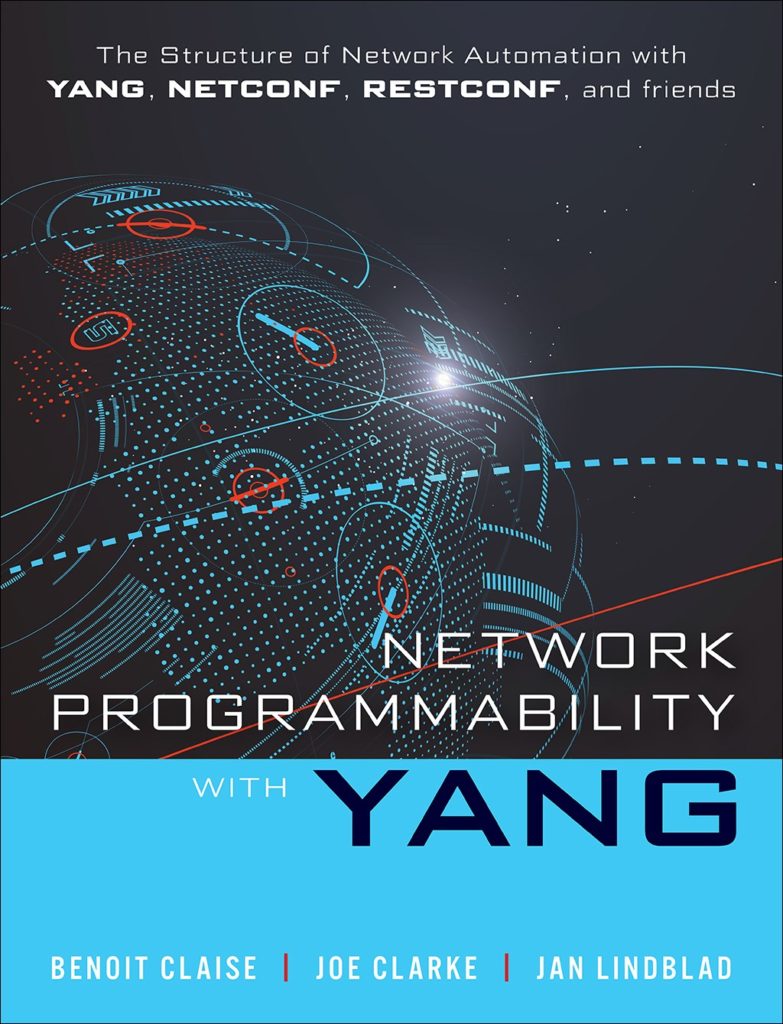
Happy to share this brand new book about data model-driven management with YANG, the first one on the topic I believe. Enjoy reading, it’s full of existing technologies and if you don’t find what you need in this big reference, let us know.
Regards, Joe Clarke, Jan Lindblad, and Benoît Claise
Reference: http://www.informit.com/store/network-programmability-with-yang-the-structure-of-9780135180396
Description
Today, networks must evolve and scale faster than ever. You can’t manage everything by hand anymore: You need to automate relentlessly. YANG, along with the NETCONF, RESTCONF, or gRPC/gNMI protocols, is the most practical solution, but most implementers have had to learn by trial and error. Now, Network Programmability with YANG gives you complete and reliable guidance for unlocking the full power of network automation using model-driven APIs and protocols.
Authored by three YANG pioneers, this plain-spoken book guides you through successfully applying software practices based on YANG data models. The authors focus on the network operations layer, emphasizing model-driven APIs, and underlying transports.
Whether you’re a network operator, DevOps engineer, software developer, orchestration engineer, NMS/OSS architect, service engineer, or manager, this guide can help you dramatically improve value, agility, and manageability throughout your network.
- Discover the value of implementing YANG and Data Model-Driven Management in your network
- Explore the layers and components of a complete working solution
- Build a business case where value increases as your solution grows
- Drill down into transport protocols: NETCONF, RESTCONF, and gNMI/gRPC
- See how telemetry can establish a valuable automated feedback loop
- Find data models you can build on, and evaluate models with similar functionality
- Understand models, metadata, and tools from several viewpoints: architect, operator, module author, and application developer
- Walk through a complete automation journey: business case, service model, service implementation, device integration, and operation
- Leverage the authors’ experience to design successful YANG models and avoid pitfalls
Table of Contents
Introduction xxii
1 The Network Management World Must Change: Why Should You Care? 2
Introduction 2
The Industry Has Changed: What Are the Trends? 6
Existing Network Management Practices and Related Limitations 24
Data Modeling Is Key for Automation 39
Interview with the Experts 48
Summary 52
References in This Chapter 53
Endnotes 53
2 Data Model—Driven Management 56
The Beginning: A New Set of Requirements 56
Network Management Is Dead, Long Live Network Management 59
YANG: The Data Modeling Language 61
The Management Architecture 69
Data Model—Driven Management Components 70
The Encoding (Protocol Binding and Serialization) 74
The Server Architecture: Datastore 77
The Protocols 78
The Programming Language 85
Telemetry 86
The Bigger Picture: Using NETCONF to Manage a Network 86
Interview with the Experts 91
Summary 93
References in This Chapter 93
Endnotes 94
3 YANG Explained 96
Introduction 96
Describe Your World of Data 96
Describing Possible Events 113
Separating Configuration from Operational Data 117
Constraints Keep Things Meaningful 122
Augmenting, Extending, and Possibly Deviating 142
Network Management Datastore Architecture (NMDA) 149
Interview with the Expert 154
Summary 156
References in This Chapter 157
4 NETCONF, RESTCONF, and gNMI Explained 158
Introduction 158
NETCONF 158
RESTCONF 190
OpenConfig and gNMI 214
Interview with the Expert 225
Summary 227
References in This Chapter 227
5 Telemetry Explained 230
Introduction 230
Data Model—Driven Telemetry 230
Moving Away from SNMP to Telemetry 232
Telemetry Use Cases 235
Telemetry Components 236
Telemetry Standard Mechanisms 242
Interview with the Experts 249
Summary 252
References in This Chapter 253
Endnotes 253
6 YANG Data Modeling Developments in the Industry 256
Introduction 256
The Beginning: The IETF 256
Embracing YANG Throughout the Industry 263
The OpenConfig YANG Model 268
Industry Coordination Is Required 270
Interoperability Testing 272
Implementing More Than One YANG Model for a Specific Functionality 274
Interview with the Expert 275
Summary 278
References in This Chapter 279
Endnotes 279
7 Automation Is as Good as the Data Models, Their Related
Metadata, and the Tools: For the Network Architect and Operator 282
Introduction 282
Getting to Know the Structure of a YANG Module 283
Finding the Right Modules Using the YANG Catalog 287
Interacting with Devices 299
Interview with the Experts 331
Summary 335
Endnotes 335
8 Automation Is as Good as the Data Models,
Their Related Metadata, and the Tools: For the Module Author 336
Introduction 336
Designing Modules 336
Understanding Your Module’s Impact 349
Interview with the Expert 350
Summary 352
Endnotes 352
9 Automation Is as Good as the Data Models, Their Related Metadata, and the Tools: For the Application Developer 354
Introduction 354
Working with YANG Modules 355
Interacting with the Network 366
Making YANG Language Native 373
Interview with the Expert 380
Summary 381
Endnotes 382
10 Using NETCONF and YANG 384
Introduction 384
So the Story Goes 385
Top-Down Service Model 386
Bottom-Up Device Templates 392
Service Logic Connecting the Dots 394
Setting Up NETCONF on a Device 398
Discovering What’s on a Device 400
Managing Services 405
Manager Synchronization with Devices 413
Network-Wide Transactions 417
Interview with the Experts 425
Summary 428
11 YANG Model Design 430
Introduction 430
Modeling Strategy 430
YANG Modeling Tips 433
Common YANG Mistakes 443
Backward Compatibility 457
Interview with the Experts 460
Summary 462
References in This Chapter 463

Permalink
How can get download th ebook
Permalink
How to download the ebook? Safari is one example. Buying the electronic version is another one.
Permalink
Hi,
I bought the book and i find it find it fabulous. Because in one hand it allows to bring together the différent technilogical briks that make up SDN in a single book and especially that is was written by people who are experts un their expert field.
Cordially Hedi.C